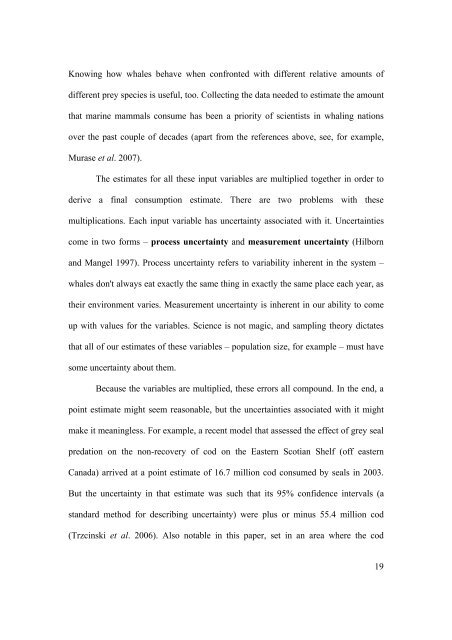ICELAND, - Whale and Dolphin Conservation Society
ICELAND, - Whale and Dolphin Conservation Society
ICELAND, - Whale and Dolphin Conservation Society
You also want an ePaper? Increase the reach of your titles
YUMPU automatically turns print PDFs into web optimized ePapers that Google loves.
Knowing how whales behave when confronted with different relative amounts of<br />
different prey species is useful, too. Collecting the data needed to estimate the amount<br />
that marine mammals consume has been a priority of scientists in whaling nations<br />
over the past couple of decades (apart from the references above, see, for example,<br />
Murase et al. 2007).<br />
The estimates for all these input variables are multiplied together in order to<br />
derive a final consumption estimate. There are two problems with these<br />
multiplications. Each input variable has uncertainty associated with it. Uncertainties<br />
come in two forms – process uncertainty <strong>and</strong> measurement uncertainty (Hilborn<br />
<strong>and</strong> Mangel 1997). Process uncertainty refers to variability inherent in the system –<br />
whales don't always eat exactly the same thing in exactly the same place each year, as<br />
their environment varies. Measurement uncertainty is inherent in our ability to come<br />
up with values for the variables. Science is not magic, <strong>and</strong> sampling theory dictates<br />
that all of our estimates of these variables – population size, for example – must have<br />
some uncertainty about them.<br />
Because the variables are multiplied, these errors all compound. In the end, a<br />
point estimate might seem reasonable, but the uncertainties associated with it might<br />
make it meaningless. For example, a recent model that assessed the effect of grey seal<br />
predation on the non-recovery of cod on the Eastern Scotian Shelf (off eastern<br />
Canada) arrived at a point estimate of 16.7 million cod consumed by seals in 2003.<br />
But the uncertainty in that estimate was such that its 95% confidence intervals (a<br />
st<strong>and</strong>ard method for describing uncertainty) were plus or minus 55.4 million cod<br />
(Trzcinski et al. 2006). Also notable in this paper, set in an area where the cod<br />
19
















